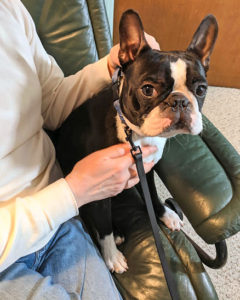Puppies are a lot of work. We say that, but people don’t really realize how much effort it takes until they’ve added one to their families. And, once you’ve fallen in love with that incredibly adorable little face (in about 10 seconds), it’s unthinkable to rethink the decision.
We know you love your puppy. We know your puppy is smartest, cutest, cuddliest creature ever to step foot on the planet. You still need some alone time. Not to mention peace and quiet.
Life of the litter
Chances are good your puppy had siblings. And, as those puppies opened their eyes, found their feet, and started developing their personalities, they played with their siblings until they were exhausted and dropped into a nap wherever they were. There was no enforced “down time.” We’re not faulting breeders at all – it’s just not a regular part of raising a litter.
The result is that your puppy has no idea how to just “chill.” He’s used to running until he’s on empty, then crashes until the energy is refilled and he’s ready to go full-tilt again. Which is adorable when you’re watching videos of puppies, and exhausting when you’re living with one.
Teaching calm
The best way to train your puppy to calm down is to start with a tired puppy. He’ll be more receptive if he’s already ready to take a nap – he just doesn’t know it.
You can accomplish tired with a vigorous 10 or 15 minutes of play – tickle the puppy, fetch, tug, etc., or with a five-minute training session. For most dogs, mental exercise is even more tiring than physical exertion. Remember how tired you were after taking a school test?
After the play or training game, take your puppy outside to eliminate. Leave his collar on when you come back inside.
Take him with you to your usual place to relax. If you’ve decided not to allow your dog on the furniture, sit on the floor with him. He can be in a dog bed, if you like.

Tuck your puppy in next to you, sitting, with your elbow holding your puppy in place. With the same hand as the arm that’s around the puppy, hold his collar with a couple of fingers.
With the other hand, gently pet the puppy until he sits quietly. If he wants to lie down, that’s fine, but don’t release your hold on him. Talk to him in a soothing voice. It doesn’t matter what you say, as long as you speak softly in a monotone voice. Be boring, yet soothing.
There’s really no time limit for this “Sit and Accept Praise” training. It takes however long it takes for your puppy to understand that nothing interesting is happening and it’s okay to nap. If you run out of time or patience, put your puppy in his crate for a nap, being sure to remove the collar for safety. If he complains, cover the crate. And leave for at least 15 minutes.
Alone time
It’s important that your puppy learns to be calm when he’s alone. If you are constantly there, always available, he won’t know how to react when you leave to go to work, school, shopping, out to dinner, etc. Separation anxiety can become a real problem in dogs. Especially if they’ve never been taught that it’s okay to be alone.
Dogs love having a schedule and rules to live by. Your puppy, despite his pitiful, mourning crying, needs to know the rules. In their social skills and intelligence, dogs are very much like toddlers. Responsible parents make the schedules for their little ones and try to stick to them whenever possible. People don’t let their toddlers set the schedule. Don’t let your puppy, either.
Set a reasonable schedule for yourself and your puppy. Include several play sessions through the day, which may be walks, training games, or unstructured play. And schedule naps, too. Most adult dogs sleep 12 to 16 hours a day, and puppies need even more sleep. Even if he doesn’t think so. Even if you have to enforce it.
Overtired
Just like human children, puppies tend to get out of control when they’re overtired. If you see your puppy’s behavior ramping up, getting wild, it’s probably a good signal it’s time for a “Sit and Accept Praise” session.
Teaching a puppy to be calm and soothe himself is another skill that a well-adjusted dog needs to know. We know it’s another thing on a list that’s already a mile long. We know that puppies are frustrating, exhausting, and relentless in wanting your attention. They’re also sponges, ready to absorb everything you’re teaching. Putting in the time now pays off throughout your dog’s life.
